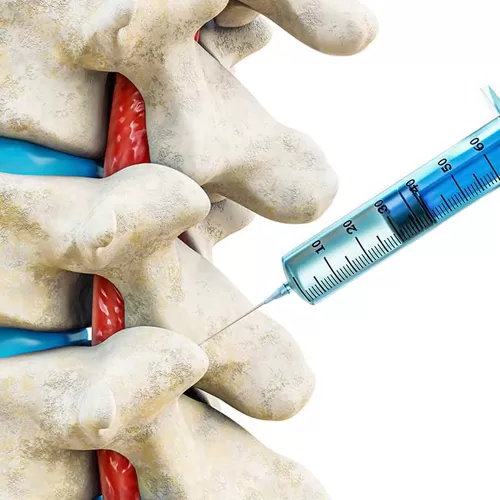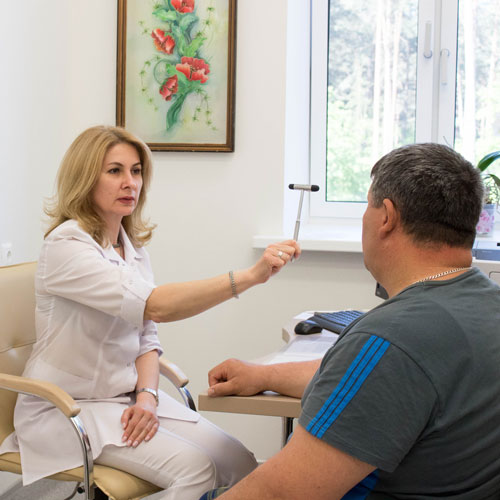
Degenerative diseases of the spine (herniated and protruded intervertebral discs, facet arthrosis, spinal canal stenosis, osteochondrosis) are the most common cause of acute and chronic back pain. The pain syndrome caused by them leads to a significant reduction in the quality of life of patients, physical activity, social and professional functioning. In the absence of indications for emergency surgical treatment, the most effective method of pain syndrome control is interventional treatment - blockade with a glucocorticosteroid drug. Due to the improvement of medical technologies, the applied methods of blockades have undergone significant changes. Blockades “blindly” have been replaced by new methods of performing blockades under ultrasound and X-ray control, which allowed to significantly increase efficiency and safety.
One of the modern methods of back pain treatment has been refined and improved at our Center - ultrasound-assisted muscle blockade, that straightens the spine. The Center's team of specialists has developed application instructions, which was approved by the Ministry of Health of the Republic of Belarus.
INDICATIONS FOR USE
Acute or chronic pain syndrome in patients aged 18 to 75 years due to:
- Osteochondrosis of the spine;
- Spondylosis (arthrosis or osteoarthritis of the spine, degeneration of the facet joints);
- Cervical, thoracic, lumbar disc herniation.
METHOD ADVANTAGES
- Prominent reduction of pain syndrome intensity (effective in almost 90% of patients);
- Minimization of complications through continuous ultrasound guidance;
- Does not require hospitalization, after the blockade is carried out, the patient is monitored for two hours;
- Prolonged effect of reducing the intensity of pain syndrome.
METHOD FEATURES
This method is performed in the operating room, equipped with all the necessary monitoring equipment. After the manipulation, the patient stays in the observation room for at least two hours.
CONTRAINDICATIONS
- Presence of generalized infection or inflammatory changes in the area of intended puncture;
- Benign and malignant tumors of the spine and/or spinal cord;
- Long-term use of medications from the glucocorticosteroid group;
- Acute spinal cord and spinal cord injuries;
- Severe congenital and acquired spinal deformities;
- Neuromuscular diseases;
- History of seizure syndrome of any etiology;
- Pregnancy and lactation.
PREPARATION FOR INTERVENTIONAL TREATMENT OF BACK PAIN
In order to increase the effectiveness of the manipulation, it is necessary to determine clear indications and contraindications. Manipulation can be prescribed by a neurologist of our Center during a consultative appointment.
You can make an appointment for a consultation with a neurologist by calling the Contact Center phone numbers.
Required examinations and documents for counseling
- Extract from the outpatient card at the place of residence, epicrises of previous inpatient treatment (if any);
- Spine MRI CD with interpretation;
- Passport.
Documents for interventional treatment
- Extract from the outpatient card at the place of residence, epicrises of previous inpatient treatment (if any);
- Pre-manipulation examination results;
- Referral from the Center's neurologist, received during consultation;
- Contract for paid services with payment receipt.
The contract for paid services is concluded at the reception desk. The cost of manipulation is indicated in the price list on the Center's website.
Pre-manipulation examination*:
- clinical blood test;
- ECG;
- MRI of the spine.
Steps:
- The patient arrives at the clinic (time and day indicated in the referral) on an empty stomach with the necessary documents and examination results (see above). The patient always takes tablets for chronic diseases in the morning and drinks a small amount of clean water..
- After paperwork and placement in the room, the anesthesiologist assesses the patient's condition and readiness for manipulation.
- The patient signs the “Informed Voluntary Consent for Interventional Pain Management” and the patient is admitted to the operating room.
- At the end of the manipulation, the patient returns to the room. If the patient is feeling well, after two hours of observation, the patient is released home with recommendations.
HOW TO GET INTO INTERVENTIONAL TREATMENT FOR BACK PAIN AT THE RCMC
- Call the Contact Center to make an appointment for a consultation with neurologist Malkov A.B. or Chechik N.M.
- Come for a consultation at the appointed time.
- Sign a contract for paid services at the reception desk, pay the bill.
- Arrive at the Center at the time indicated in the referral from the neurologist.
Information provided on the website is for informational purposes only, subject to change.




